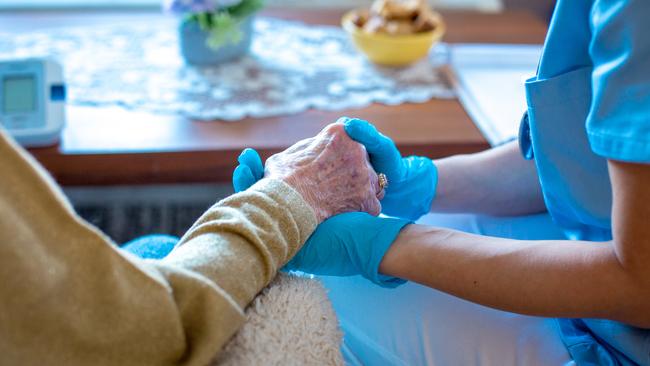Aged-care surge workforce help a ‘drop in ocean’
The surge workforce is filling less than 5 per cent of vacant shifts in the aged-care sector based on the industry’s estimates of staff absenteeism.

The federal government’s surge workforce is filling less than 5 per cent of vacant shifts in the aged-care sector based on the industry’s estimates of Covid and influenza-related staff absenteeism.
Analysis of Department of Health data by The Australian has revealed the commonwealth’s surge workforce – which includes GPs, nurses, personal care workers and allied health workers – has filled an average of 2168 shifts a week since the government took office in May.
The Aged and Community Care Providers Association, the nation’s overarching body representing residential, home and community care and retirement living, has estimated the industry is facing about 48,000 unfilled shifts in residential aged-care homes each week. With Covid-19 and influenza case numbers rising in recent weeks amid a winter Omicron wave – which peaked at more 15,000 cases in aged care in late July – ACCPA estimates about 10 per cent of staff are off work sick.
ACCPA chief executive Paul Sadler said the current support from the federal government was a “drop in the ocean” of what was needed.
“It is low, but it is some contribution, which is helpful to the aged-care workforce,” he said.
“In some cases we have been hearing regular reports from providers who have had up to 20 per cent of their staff off sick due to Covid-19 or the flu, so the government has been able to fill a couple of thousand shifts a week compared to shortages of 48,000 a week.
“It is a meaningful contribution but it is not meeting the level of unmet shifts in the sector at the moment.”
However, the sector is better prepared to deal with the current outbreak with higher rates of vaccination, larger stocks of personal protective equipment, antivirals and a sustainable supply of rapid antigen tests.
By comparison, Mr Sadler said there were about 140,000 shifts going unfilled over the nation’s Omicron summer, or about a quarter of all shifts.
Under the Morrison federal government, the surge workforce was able to fill an average of 1432 shifts or about 1 per cent of what was needed.
The former government boosted health staff by about 1822 when the sector faced its deadliest week, when 227 people died.
Aged Care Minister Anika Wells said the royal commission had acknowledged that workforce shortages had been a “longstanding problem” and the government was responding.
“We absolutely need more workers in aged care, which is why we made our submission to the Fair Work Commission on Monday for a significant and meaningful pay rise,” she said.
“We have committed to funding the outcome of this case because a pay rise is critical to attracting staff back to the sector following nine years of neglect. There are aged-care workers earning $22 an hour and shelves stackers at supermarkets earning $25.
“Unlike the Morrison government, we have a winter plan which includes the extended use of the surge workforce that filled 2751 shifts last week (to August 5) and up to 250 ADF personnel. The Australian Defence Force has provided support to 497 residential aged-care facilities.”
Aged-care provider Whiddon chief executive Chris Mamarelis said the government’s surge workforce was “completely depleted” and his organisation was facing extreme challenges accessing workers.
Mr Mamarelis said Whiddon had booked about 90 out of 223 commonwealth surge workers based on the latest review of its staff portal but would normally be “lucky” to see a third of all shifts helped by the extra staff.
Over the long term, Mr Mamarelis said Australia was “completely behind the eight ball” in a global recruitment campaign for more aged-care and nursing workers.
“Workforce is our biggest challenge right now,” he said.
“We are seeing so many shifts go unfilled and recruiting into the roles is extremely difficult.
“The government has made its submission to Fair Work that the workers need to be paid more and that it is fully funded by the government, which they have been committed to doing.
“There are some skilled employees coming in from overseas but we are still going through so much red tape and waiting weeks and months in some cases to access those people, while also competing on the international stage with a global shortage of care staff.”
In the lead-up to the election, Anthony Albanese campaigned heavily on a platform to fix the aged-care sector, promising to fund pay rises for nursing home workers as well as $2.5bn in other measures, including having a registered nurse on site 24 hours a day by July 2023.
Ms Wells said in July that government modelling showed about 869 additional nurses were needed to meet Labor’s election commitment of increasing minimum care times in residential homes.
The aged-care sector has rejected this figure, with Mr Sadler arguing that ACCPA modelling showed it would be more like 1,400 workers.






To join the conversation, please log in. Don't have an account? Register
Join the conversation, you are commenting as Logout